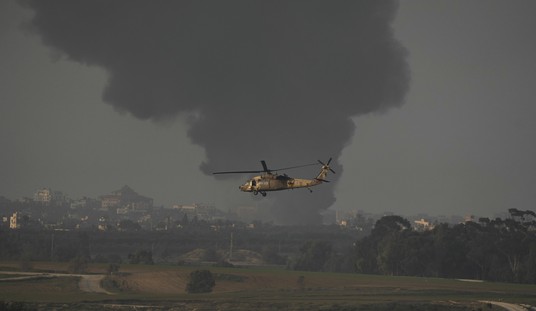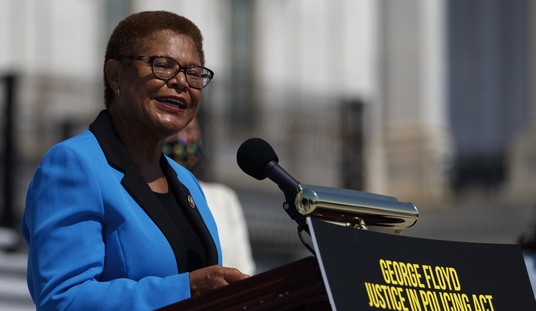In the July issue of Townhall Magazine, where this article originally appeared, Mark Kakkuri gives an in-depth look at the history behind one of America's most iconic guns.
Designed in the early 1900s by John Moses Browning, the 1911 pistol— named for the year it was adopted by the U.S. Army as its standard sidearm— still serves America today. Although the U.S. Army switched to the Italian Beretta M9 pistol in 1985 and the majority of U.S. police departments issue Austrian Glock pistols to their officers, the American born 1911—most well known as a .45 caliber automatic Colt pistol, or .45 ACP—continues to thrive in 2014 despite a few apparent shortcomings.
The 1911 is an old school design that has a lower ammunition capacity and higher price when compared with modern pistols. Still, its vast service record, especially iconic in World War II, has forever cemented its place in American history. And the legacy continues: The U.S. Marines (Special Operations Command) recently adopted a modern Colt 1911 to serve as its close quarters battle pistol.
Among firearms aficionados, the 1911 has a cult following and interested readers can find heated “1911 vs. [any other gun]” discussions abounding in online gun forums. Indeed, shooters new and old engage each other in friendly debates at gun stores and gun ranges everywhere. Regardless of the stance one takes toward the 1911 pistol and its efficacy as a fighting weapon, its history and legacy in America seem unparalleled.
AN AMERICAN DREAM
“At the very least, the 1911 pistol is a means of connection with our American heritage,” says Roger Eckstine, the Houston, Texas-based author of the “Shooter’s Bible Guide to Home Defense” and a widely published writer of in-depth tests and evaluations of firearms, shooting techniques, and equipment.
In reminiscing about the 1911, he cites the trajectory of world events leading up to World War II and the 1911’s role as the U.S. Army’s sidearm through it and other wars. Before those events, says Eckstine, Browning had the vision for a better weapon and invented the 1911 pistol, taking personal, professional, and financial risks to bring it to fruition. Once built, it had to compete with other designs for acceptance by the U.S. military. “That Browning was successful is not necessarily what defines the American dream,” says Eckstine. “That he had the opportunity to pursue this path at all was the real prize.”
Recommended
A MODERN LEGACY
Despite the pistol’s unique 100-year history and decades of service as the U.S. Army soldier’s sidearm, Eckstine marvels that we can buy virtually the same gun today, or one that has been improved upon by relatively simple means. “No one would buy an automobile today that was made to the technological standards in 1911,” he says. “Its reliability would be atrocious. Its level of comfort would be comparatively brutal and its operation would prove extremely demanding. Modern performance and safety standards would likely rule it out of existence demanding not only a complete redesign but also significant changes of material. Yet, go to any major pistol competition today and you will find that the 1911 not only remains the most popular but also the most successful design to date.”
Beyond the 1911’s active use in modern-day pistol competitions and the recent issuance of the 1911 to a select group of U.S. Marines, several police departments around the nation still issue the 1911 to officers. In fact, the Hurst, Texas Police Department has issued the 1911 for duty since 1974. Hurst PD Assistant Chief Richard Winstanley says Hurst officers may carry their own pistol as long as it is a 1911 chambered in .45 ACP. “Nothing else is approved for duty carry.”
FUNCTIONALLY CHALLENGED AND ENORMOUSLY POPULAR
Now designed and produced by several firearms manufacturers, at first the 1911 pistol appears to be ill-equipped for its work in competition, military, or police service. It carries only seven or eight rounds in a single magazine, compared to modern pistol designs that can carry more than 15. Also, the 1911 usually weighs more than its modern counterparts. Moreover, the design has proven to be more expensive to build, manufacture, and maintain than other modern pistol designs.
Those costs are passed on to customers and so some 1911s can be twice or more the price of other modern pistol designs. Further still, some 1911s are picky and finicky about what ammunition gets fired through them. Despite all that, the 1911 remains popular.
One of the reasons for this, says Richard Mann, the Princeton, West Virginia-based author of “Handgun Training for Personal Protection” and contributing editor to several firearms magazines, is that the 1911 has been properly vetted. “It has been proven. The decreased reliability and finickiness of the 1911 is not a product of the design but more the result of the pistol being manufactured by a wide variety of builders with mass-produced parts,” he says. “The best-made 1911s work very well. It is the copies that can be problematic.”
BIGGER IS BETTER
Another reason for the 1911’s popularity is the effectiveness of the round it fires. According to Bob Shimizu, shooting instructor at the Paulden, Arizona-based Gunsite Academy, the .45 ACP round was designed after U.S. Marines encountered the Moro guerrillas in the Philippines. The .38 Special rounds of the day were not effective against the enemy combatants, so something with more knock-down power was needed. Comparatively, the .45 ACP bullet is larger and weighs more than most other handgun bullets. “Big, heavy bullets work better,” says Shimizu. “They stop the fight with impact and they create larger wound channels.”
On the matter of the 1911’s relatively low ammunition capacity, Eckstine recommends focusing more on the size of the cartridges as opposed to the amount. “Ask any emergency medical technician if they would rather staunch a small hole or a big hole. Then consider how manufacturers of cartridges smaller than the .45 ACP are always talking about getting proper expansion. Even non-expanding .45 ACP bullets start with creating a hole measuring at least 0.451 inches across.”
Regarding the amount of ammunition a 1911 carries, however, Eckstine points out that the average confrontation ends after only a few shots. “Read the Armed Citizen pages in the NRA member publications. Not one incident of gunfire in a self-defense situation that I can recall has ever required a reload.”
SIMPLE ELEGANCE
Other handguns fire the .45 ACP cartridge so the 1911’s appeal can’t entirely be based on the cartridge that it fires. Shimizu also cites some design elements that, in combination, are unique to the 1911. The pistol has elegance, he says, noting that it can easily be taken apart for a routine or detailed cleaning and that its 17 degree grip angle offers the most natural fit to the human hand and allows instinctive aiming. He notes the two mechanical safeties that require both a firm grip on the pistol as well as an external lever moved to allow the trigger to be squeezed.
A subjective matter, the 1911 nonetheless often gets high praise for how it fits a human hand. Further, the design of the pistol puts the centerline of the barrel closer to the user’s hand than many other pistols. This results in greater control of recoil, which leads to faster recovery of a usable sight picture when aiming and faster follow through for each shot. In addition, the flat sides of the grip frame help the shooter point the gun at a target.
THE TRIGGER
Beyond feel in the hand, trigger control is of the utmost importance, says Eckstine. The 1911 trigger, part of a firing mechanism referred to as “single action,” travels a very short distance straight back—a short and precise movement to the point of ignition. And recovery and reset of the 1911 trigger after firing is quicker and easier than any other design. Other trigger systems, including “double action” triggers that travel a longer distance while moving a hammer or striker back as well as releasing it to fire, work via a hinge that moves the trigger in an arc. This motion is inherently less intuitive and may not match well with the gun rocking up and down with recoil after every shot. “This is why very few non-1911 pistols offer a full time single action trigger,” he says. “The majority of non-1911 pistols require a long movement with little ‘feel’ and a longer reset that makes the trigger less precise.”
Roger Jendrusina, an NRA-certified instructor at the Brighton, Michigan-based Island Lake Shooting Center, adds that the 1911 is a fine work of craftsmanship, requiring the attention to detail that only a qualified gunsmith can provide in order to “tune” it properly for reliable service and effective use. “It is like a highly-tuned sports car, the ‘race gun’ of the firearms industry,” he says. “It will grab your attention every time it appears on the cover of a magazine.”
Designed for the .45 ACP cartridge, the firearm is accurate and has very manageable recoil. Its heavy frame allows for better absorption of the recoil and the trigger has minimal travel, which improves trigger control and accuracy. “Just like a sports car with a manual transmission and tuned suspension, the 1911 is not for everyone,” says Jendrusina. “This pistol is for the firearm enthusiast, yet almost every firearm manufacturer is producing a 1911 variant to meet the steady demand.”
A DUTY WEAPON FOR SOME
Despite the 1911’s American legacy, the myriad advantages of the design, and consumer demand, the majority of the nation’s military and police forces don’t use it. One reason for this, says Mann, is cost. “You cannot make a good 1911 for what you can make a plastic pistol,” he says, referring to the polymer, or plastic framed designs of most modern pistols.
Beyond the higher cost, Jendrusina says the mechanical thumb safety and greater weight also contribute to less use by law enforcement officers. But ironically, he says, “Many of those same professionals will participate in competition on weekends using a 1911!”
According to Shimizu, however, many police departments and some military organizations still use the 1911 as a duty weapon. He cites Maricopa and Yavapai counties in Arizona and the Los Angeles SWAT team as examples. “The view of most Western departments is that, ‘If you can qualify with it, you may carry it.’”
That is less true for most departments back East. For example, in New York the Glock design is the only pistol an officer may carry. Other jurisdictions have other policies, and while U.S. soldiers don’t generally carry 1911s, some military special operations personnel do.
In Hurst, Texas, Winstanley says the 1911 as a duty weapon is so ingrained in that city’s police department that their officers have a unique serial number series (e.g. “HURSTPD001-”) for all their duty guns. Yonkers, New York-based Kimber Manufacturing made all of the 1911s for the Hurst PD. Winstanley says Kimber “truly understood the place in history of the 1911 in our agency.”
THE 1911 AND CONCEALED CARRY
In addition to the use of the 1911 by police and military, many civilians with concealed pistol licenses choose the 1911 for their defensive handgun needs, despite a perception that the 1911 is an “expert’s” pistol.
Mann explains that this does not mean it is a pistol to only be used by experts, but that it is a pistol often chosen by experts. In fact, he says, when new shooters are given an option they often find that the 1911’s thumb safety is a common sense switch that, when used properly, will keep them from shooting themselves when holstering.
They also discover that the 1911’s grip safety makes them obtain a proper grip when shooting. And they realize that the 1911’s 50-50 weight distribution between the “upper” (the slide and barrel) and “lower” (the frame) makes the pistol easy to control even when chambered for .45 ACP.
“As far as for civilian carry, the ability to conceal the weapon and carry it comfortably is, next to reliability, the prime consideration. For those that can do that with a 1911 it is a great choice,” Mann says.
In addition to the multiple safeties and good balance, Jendrusina adds that the 1911 is an excellent choice for concealed carry because of its narrow profile and .45 ACP stopping power. But, Jendrusina warns, “every person who carries a firearm for protection must practice, practice, practice.”
A HIGHLY-TUNED MACHINE
Deploying any firearm must become part of the operator’s muscle memory conditioning. “The civilian who chooses the 1911 must be intimately familiar with all of its controls and how to manage stoppages,” he says. “Just because we drive a two- door automobile to work every day does not mean we are ready to jump into a highly-tuned Indy car [and] take it for a spin at the Speedway. We need to practice with the firearm we use for protection.”
According to Shimizu, the 1911 perhaps asks more of its owner than other such designs because it is possible to carry the pistol with a round chambered, the hammer cocked, and the safety lock engaged, commonly referred to as “cocked and locked.” In this mode of carry the pistol can be brought into action very quickly through a specific series of motions, motions that must be learned and practiced to maintain proficiency, he says.
As an American citizen, you have the absolute right to keep and bear arms, Shimizu says. However, you also have a grave responsibility to carry out that right with the force of law and within the bounds of morality, Shimizu adds. To discharge this responsibility properly, everyone who decides to own a gun should seek out proper training, not only in how to operate firearms safely but also to understand under which circumstances one must use deadly force.
“At this point, the 1911 design is part of American culture, at least amongst those who exercise their Second Amendment rights,” says Shimizu. “Its 100 years of service has created an extensive body of knowledge, to the point that one could (and many have) write a book on the design.” •
Mark Kakkuri is a freelance writer in Oxford, Michigan. You can follow him on Twitter: @markkakkuri

























Join the conversation as a VIP Member